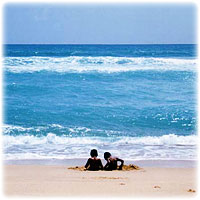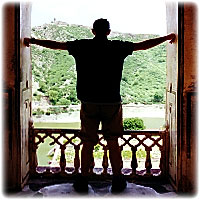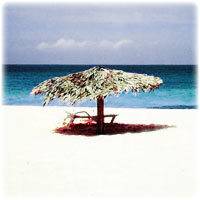Digital Travel Photography Tips
Travel photography is fantastic! You save your money to get away from it all on a trip somewhere, and what better way to keep those memories than some great photographs.In a few years from now, will you still look fondly at those souvenir fridge magnets and 'seemed like a good idea at the time' pottery animal set as you do your photos?
Probably not. Which is why I have always believed that the best souvenirs are your photos.
They are cheap, they are unique, and the memories come flooding back when you look through them (even if you don't want to be reminded that you once sported some best-forgotten hairstyles!).
It's for these reasons that travel photography is so popular. After all, do you know anyone who doesn't take a camera on holiday?
Here you'll find some digital travel photography tips that cover the following areas:
- Travel photography tips - before you leave
- Travel photography ideas on what to photograph
- Tips on travelling with your digital camera
- Share your photographs!(opens in new window)
Travel photography tips - before you leave
 Before you even set foot in your new destination there is something you need to have done - familiarised yourself with your camera.
Before you even set foot in your new destination there is something you need to have done - familiarised yourself with your camera.
Picture the scene . . . there you are poking your camera out of the train window trying to get a shot of the water buffalo as you whiz past. But it's blurry. So you hunt through your menus trying to find the sports mode that you know has a fast shutter speed to freeze movement.
And you hunt for it . . . and keep hunting . . . .and finally, there it is! Sports mode! You poke your camera back out of the train window and take a picture of . . . a housing block! What happened to the water buffalo? You whizzed past them ages ago while you were fiddling with your camera.
Ok, so that's an extreme example. But it gets the point across. Before you set out on your trip get to know your camera. It will help to avoid missed photos, and also, by choosing the right settings, it might improve your photos too. A couple of travel photography familiarisation tips for you:
- Read your instruction manual (in fact, didn't your manual say "read through this manual before using this camera"?)
- Practice with your camera in the various modes/settings. It's digital photography, so it will cost you nothing but a little time to do so.
Travel Photography Tips - What To Take

Digital cameras come with a multitude of accessories; the camera, the memory card, the battery, the charger, the lead, the case, lenses (if it's a digital SLR) . . . phew!
When you are planning your trip away there are a couple of camera related things to put on your checklist.
- Check that you have packed everything that you need. If you usually leave the charger lead plugged in to your socket at home, make sure you unplug it and take it with you.
- If you are travelling abroad, check the voltage of the country you will be travelling to. You may need to take a travel plug adaptor. And if your charger doesn't work on different voltages (quite a lot actually do, but check it), you may need to get a new charger.
Travel Photography Tips - Memory Cards
When it comes to memory cards, all is not as it may seem. Memory cards continue to grow in both size and speed. So what should you be packing?Concerning size, first you need to find out how many photos you can fit onto a card.
- To do this, put your existing memory card into your digital camera.
- Set your camera options to maximum resolution (probably labelled "Large", or "Largest").
- Set the quality setting to the second best (Probably called "fine" (rather than "superfine"), or maybe "good" rather than "best"))
Why do I suggest using your second best quality and not the best? The difference to your eyes will be minimal, but the difference in how many photos you will be able to get on the card will be huge. If you're travelling, you have to compromise a little on the quality in order to get the quantity. - Once you have set your camera up, format the memory card but make sure you have saved any photos on the card to your computer first!
- When you have formatted your card look at your camera screen to see how many photos you will be able to fit onto that card.
 The next decision is personal choice - how many photos do you think you will take? Remembering that with digital travel photography you will probably take more photos than with traditional travel photography.
The next decision is personal choice - how many photos do you think you will take? Remembering that with digital travel photography you will probably take more photos than with traditional travel photography.
Once you have a rough idea, you will know how much memory you should take on your trip.
As a final travel photography tip concerning memory cards - if you are going to be buying some new cards for your trip it's a good idea to buy a few smaller capacity memory cards, rather than just one big one.
For example, instead of buying one 4GB card, buy four 1GB cards instead.
The reason is that if you lose your camera, or your card, all your photos will be lost. If you have more than one card, at least some photos can be salvaged.
Travel Photography Tips - Batteries
 Most modern digital cameras come with their own individual batteries. Unfortunately, they cannot be easily replaced in the way that standard AA batteries can be.
Most modern digital cameras come with their own individual batteries. Unfortunately, they cannot be easily replaced in the way that standard AA batteries can be.
If your trip is short, and you know that one fully charged battery will be OK for your trip, you have nothing to worry about.
However, if you are going for longer than a battery will last you have three choices - keep a close eye on your battery usage, take the charger (and adaptor plugs if needed) with you, or buy more batteries for your camera.
Here's a few things you can do to get the most out of a fully charged battery:
- If your digital camera also has a viewfinder, and you can turn the LCD screen off when taking photos, do so. Digital camera screens guzzle battery juice like a Hummer guzzles fuel.
- Avoid the temptation to use the playback function to keep admiring your recently taken photos. Save that for when you get home.
- Turn your camera on only when you need it, and remember to turn it off again when you're done taking photos.
- Avoid taking photos in extreme cold conditions if possible - batteries hate the cold!
Would I do all this? No way! I'd pack my charger and adaptor plugs and snap away! One of the joys of digital photography is being able to see what you are taking a photo of, and then passing around your photos for others to see.
If your trip is short, or you can be sure you can charge your camera's battery every night, then one battery should suffice. If however you think you will be away from electricity for a while, then consider taking spare batteries.
Because the batteries are specific to camera manufacturers you will have to either buy spares from a camera shop, or online. Better bargains can be had online, but you will need to plan this in advance to make sure they are delivered in time.
More travel photography tips:
If you enjoyed this article you might also be interested in...
- Ideas of what to photograph when you're away
- Tips on travelling with your camera
- Newsletter back issues - great photography tips in every issue!
- Digital photography tutor home page
